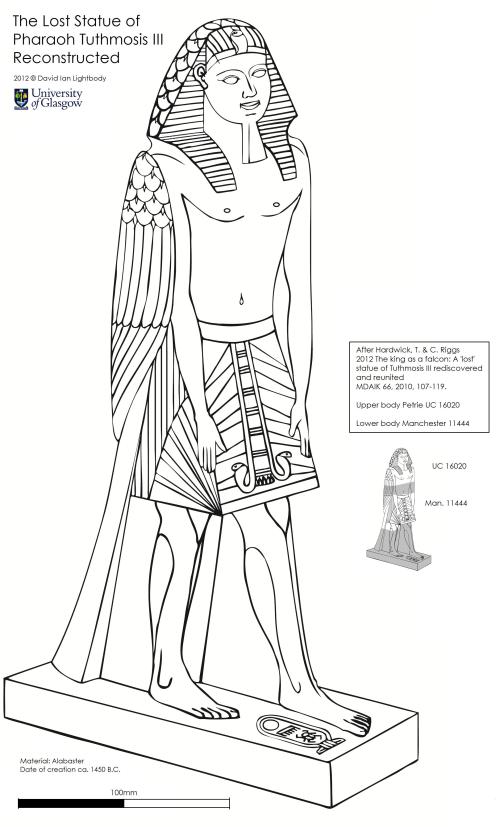September 14, 2012 by Campbell@Manchester
This broken travertine (or ‘Egyptian alabaster’) statuette is a rare example of its type, but only recently was its importance recognised. It provides a fascinating case study of the ‘biography’ of objects, both ancient and modern. Though traces of a plaster mount indicated that it had once been on display, for many years it languished in storage. Its unusual form – of a striding man seemingly cloaked in a feathered garment – made it difficult to categorise. It was therefore (as so often with problematic Pharaonic material) given a nebulous ‘Late Period’ date in the museum register. Yet neither the style nor the choice of stone fit with such a date, and the position of the statue’s hands on a royal kilt clearly mark this as an image of a king.
In 2004, the fragment was identified by Tom Hardwick and Christina Riggs as the same as that published in an excavation report. The piece had been discovered in 1905 by Arthur Weigall in the mortuary temple of Tuthmose III on the Theban west bank, making an identification with that king most likely. Exactly how the fragment got to Manchester is not known for sure, but likely involved an unrecorded division of finds followed by private sale.
Hardwick and Riggs tracked down a contender for the upper part of statue in the Petrie Museum in London. It was also made from travertine and showed a nemes-wearing king with feathered backing, but was widely considered to be a fake. It seemed possible, however, that rather than being an out-and-out forgery, this was a genuine – and probably damaged – object that had been altered in modern times in order to make it more saleable on the art market.
Analysis under ultra-violet light revealed several patches of fresh working of the stone, confirming that the upper part of the statue had indeed been given a face-lift in comparatively recent times. The Petrie and Manchester pieces do not join exactly, probably because the lower half was used as a hammer stone and has been somewhat abraded. This is
unsurprising as it sits very nicely in the hand (I’ve tried) and is potentially perfect for pounding. Yet the combination of common material and highly unusual iconography argue strongly that the two pieces belong to the same statue. The appearance of the original piece has been reconstructed by David Lightbody, a colleague at the University of Glasgow.
But what of the meaning of this form of royal representation – and why are there not more ‘kings with wings’? In the same way as the Egyptian king could adopt the classic form of the sphinx, so he might take on physical aspects of the god Horus, the falcon. Indeed, a small number of parallels exist in other collections for the ‘pharaoh as falcon’. Yet, while this statue-type appears as part of the repertoire of royal images presented to the god Amun in a scene of Tuthmose IV at Karnak, this way of representing the king appears to be limited to the mid-Eighteenth Dynasty.
 It seems likely that the ancient Egyptians were less comfortable with a feathered pharaoh than – say – Hollywood was in the 1950s, when Yul Brynner’s Ramesses II donned his ‘rishi’ cloak in the film ‘The Ten Commandments’. Depicting the king with both arms and wings may have offended the Pharaonic sense of artistic decorum, so the form never became widespread.
It seems likely that the ancient Egyptians were less comfortable with a feathered pharaoh than – say – Hollywood was in the 1950s, when Yul Brynner’s Ramesses II donned his ‘rishi’ cloak in the film ‘The Ten Commandments’. Depicting the king with both arms and wings may have offended the Pharaonic sense of artistic decorum, so the form never became widespread.
A full account of this very special piece is published as:
TOM HARDWICK and CHRISTINA RIGGS. ‘The King as a Falcon: A ‘Lost’ Statue of Thutmose III Rediscovered and Reunited’, Mitteilungen des Deutschen Archäologischen Instituts Abteilung Kairo 66 (2010), 107-119.
The conserved statue fragment will be on display once more from October.
http://egyptmanchester.wordpress.com/2012/09/14/object-biography-9-a-rare-king-with-wings-acc-no-11144/
In 2004, the fragment was identified by Tom Hardwick and Christina Riggs as the same as that published in an excavation report. The piece had been discovered in 1905 by Arthur Weigall in the mortuary temple of Tuthmose III on the Theban west bank, making an identification with that king most likely. Exactly how the fragment got to Manchester is not known for sure, but likely involved an unrecorded division of finds followed by private sale.
Hardwick and Riggs tracked down a contender for the upper part of statue in the Petrie Museum in London. It was also made from travertine and showed a nemes-wearing king with feathered backing, but was widely considered to be a fake. It seemed possible, however, that rather than being an out-and-out forgery, this was a genuine – and probably damaged – object that had been altered in modern times in order to make it more saleable on the art market.
Analysis under ultra-violet light revealed several patches of fresh working of the stone, confirming that the upper part of the statue had indeed been given a face-lift in comparatively recent times. The Petrie and Manchester pieces do not join exactly, probably because the lower half was used as a hammer stone and has been somewhat abraded. This is
unsurprising as it sits very nicely in the hand (I’ve tried) and is potentially perfect for pounding. Yet the combination of common material and highly unusual iconography argue strongly that the two pieces belong to the same statue. The appearance of the original piece has been reconstructed by David Lightbody, a colleague at the University of Glasgow.
But what of the meaning of this form of royal representation – and why are there not more ‘kings with wings’? In the same way as the Egyptian king could adopt the classic form of the sphinx, so he might take on physical aspects of the god Horus, the falcon. Indeed, a small number of parallels exist in other collections for the ‘pharaoh as falcon’. Yet, while this statue-type appears as part of the repertoire of royal images presented to the god Amun in a scene of Tuthmose IV at Karnak, this way of representing the king appears to be limited to the mid-Eighteenth Dynasty.

Royal statues donated to Amun. A block from the 3rd pylon at Karnak, originally part of a chapel of Tuthmose IV. S. Sauneron, BIFAO 70 (1971), pl. LXIX.
A full account of this very special piece is published as:
TOM HARDWICK and CHRISTINA RIGGS. ‘The King as a Falcon: A ‘Lost’ Statue of Thutmose III Rediscovered and Reunited’, Mitteilungen des Deutschen Archäologischen Instituts Abteilung Kairo 66 (2010), 107-119.
The conserved statue fragment will be on display once more from October.
http://egyptmanchester.wordpress.com/2012/09/14/object-biography-9-a-rare-king-with-wings-acc-no-11144/




